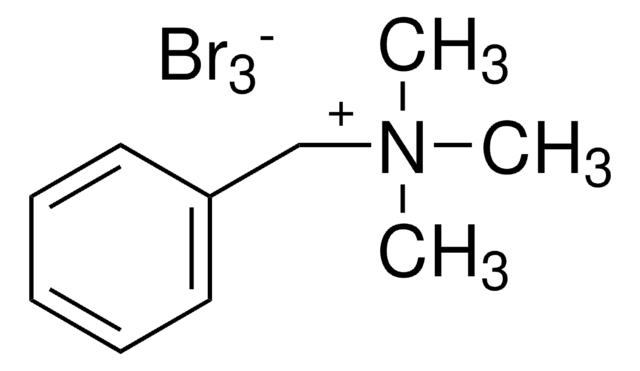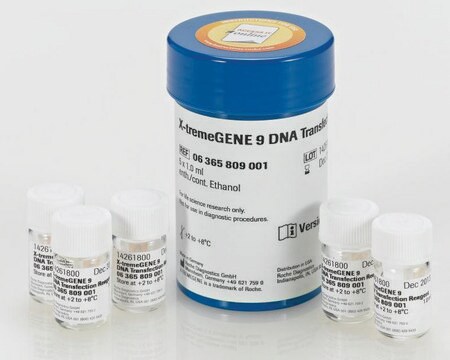11202375001
Roche
DOTAP Liposomal Transfection Reagent
>99% (TLC), liquid, suitable for transfection
Sinônimo(s):
DOTAP methosulfate, liposomal transfection reagent, dotap, transfection reagent, dotap, N-(2,3-Dioleoyloxy-1-propyl)trimethylammonium methyl sulfate, Transfection reagent
About This Item
Produtos recomendados
descrição
N-[1-(2,3-Dioleoyloxy)propyl]-N,N,N-trimethylammonium methyl-sulfate
Nível de qualidade
Ensaio
>99% (TLC)
Formulário
liquid
embalagem
pkg of 5 × 400 μL (10 U/μl)
fabricante/nome comercial
Roche
técnica(s)
transfection: suitable
temperatura de armazenamento
2-8°C
cadeia de caracteres SMILES
[H]C(C[N+](C)(C)C)(OC(CCCCCCC/C=C\CCCCCCCC)=O)COC(CCCCCCC/C=C\CCCCCCCC)=O.O=S([O-])(OC)=O
InChI
1S/C42H80NO4.CH4O4S/c1-6-8-10-12-14-16-18-20-22-24-26-28-30-32-34-36-41(44)46-39-40(38-43(3,4)5)47-42(45)37-35-33-31-29-27-25-23-21-19-17-15-13-11-9-7-2;1-5-6(2,3)4/h20-23,40H,6-19,24-39H2,1-5H3;1H3,(H,2,3,4)/q+1;/p-1/b22-20-,23-21-;
chave InChI
RSMRWWHFJMENJH-LQDDAWAPSA-M
Procurando produtos similares? Visita Guia de comparação de produtos
Categorias relacionadas
Descrição geral
Aplicação
Características e benefícios
- Easy to use: The lipid dispersion is simply mixed with the DNA solution, then applied directly to the cells
- Highly effective: 5 to 100-fold more effective than the calcium phosphate or DEAE-dextran method
- Gentle: No cytotoxic effects
- Flexible: Equally effective in the presence or absence of serum. Effective on a wide range of species (e.g., insect cells, mammalian cells) and a variety of different cell types. Can be used for either transient or stable transfection procedures.
- Aqueous dispersion (liposomes) in MBS (MES-buffered saline, pH 6.2) (bottled under argon), 1mg/ml, sterile-filtered.
Nota de preparo
The optimal working concentration is dependent on several parameters, including the cell line being used, concentration and type of nucleic acid (DNA, RNA), and incubation time. It is important to optimize the transfection conditions for the individual cell type studied.
Cytotoxicity: Not cytotoxic up to a concentration of 100μg/ml (PBLs, HeLa cells).
Outras notas
Código de classe de armazenamento
12 - Non Combustible Liquids
Classe de risco de água (WGK)
nwg
Ponto de fulgor (°F)
does not flash
Ponto de fulgor (°C)
does not flash
Escolha uma das versões mais recentes:
Já possui este produto?
Encontre a documentação dos produtos que você adquiriu recentemente na biblioteca de documentos.
Os clientes também visualizaram
Artigos
This brief webinar provides an overview of what transfection is and the methods that are used to introduce DNA or RNA into eukaryotic cells.
Conteúdo relacionado
Browse our convenient transfection reagent selection guide to match the best reagent for your specific cell line and application needs.
Nossa equipe de cientistas tem experiência em todas as áreas de pesquisa, incluindo Life Sciences, ciência de materiais, síntese química, cromatografia, química analítica e muitas outras.
Entre em contato com a assistência técnica




![Fluorescent DOTAP 1-oleoyl-2-[6-[(7-nitro-2-1,3-benzoxadiazol-4-yl)amino]hexanoyl]-3-trimethylammonium propane (chloride salt), powder](/deepweb/assets/sigmaaldrich/product/structures/262/741/3634e622-7f85-4907-beb5-5f2137c95947/640/3634e622-7f85-4907-beb5-5f2137c95947.png)






